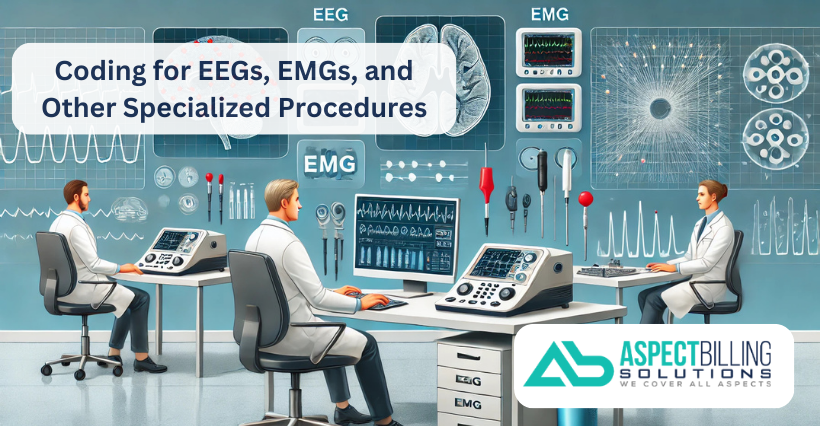Tips for Coding for EEGs, EMGs, and Other Specialized Procedures
Introduction
Accurate medical coding is the backbone of efficient healthcare operations, especially for specialized procedures like EEGs, EMGs, and other neurodiagnostic tests. These codes ensure correct billing, compliance, and reimbursement, which ultimately supports patient care. But coding for these procedures can be tricky due to their complexity. Let’s break it down to make your coding tasks smoother and more accurate.
Understanding the Basics of EEGs and EMGs
What Are EEGs?
Electroencephalograms (EEGs) measure electrical activity in the brain. They’re used to diagnose conditions like epilepsy, sleep disorders, and brain injuries. With electrodes placed on the scalp, EEGs capture brain wave patterns, offering critical insights into neurological health.
What Are EMGs?
Electromyograms (EMGs) assess the health of muscles and the nerves controlling them. They’re often used to diagnose conditions like neuropathy, myopathy, or motor neuron disorders. By inserting fine needles into muscle tissue, EMGs provide real-time feedback on muscle activity.
Why Accurate Coding Matters
Proper coding ensures:
- Appropriate Reimbursement: Incorrect codes can lead to underpayments or denials.
- Regulatory Compliance: Mistakes might raise red flags during audits.
- Clear Medical Records: Precise documentation aids in continuity of care and future diagnostics.
Key Challenges in Coding for EEGs and EMGs
Complex Documentation
Handling detailed reports and test results can be overwhelming. Missed or misunderstood details can result in incorrect coding.
Frequent Updates to Codes
CPT codes for EEGs, EMGs, and related procedures are periodically revised. Staying updated is critical to avoid using outdated codes.
Best Practices for EEG and EMG Coding
Familiarizing with CPT Codes
Learn the most commonly used codes:
- EEGs: 95812, 95813 (routine), 95957 (digital analysis)
- EMGs: 95860, 95861 (limited or extensive studies) Keep a coding manual handy to verify specifics and avoid errors.
Understanding Modifiers
Modifiers clarify unique circumstances of procedures:
- Modifier 26: Professional component
- Modifier TC: Technical component Apply modifiers accurately to prevent claim rejections.
Leveraging Medical Documentation
Detailed records are essential. Ensure reports specify:
- Procedure duration
- Specific findings
- Any anomalies observed
Specialized Procedures Beyond EEGs and EMGs
Nerve Conduction Studies (NCS)
NCS often accompanies EMGs. Use codes like 95905 or 95910, ensuring documentation includes nerves tested and conduction speeds.
Evoked Potentials (EPs)
Evoked potentials assess sensory pathway function. Codes like 95925-95927 apply. Record stimulus type and patient responses clearly.
Tools and Resources for Coders
Coding Software
Invest in tools that:
- Auto-update with CPT changes
- Flag potential errors
Training and Certification
Consider certifications like Certified Professional Coder (CPC) or Certified Coding Specialist (CCS). Organizations like AAPC and AHIMA offer excellent resources.
Avoiding Common Mistakes
Misinterpreting Medical Terminology
Brush up on terminology specific to neurology to avoid errors.
Overlooking Code Bundling Rules
Ensure codes that are part of a bundle aren’t billed separately. Use tools or references to verify.
How to Stay Updated
- Subscribe to medical coding newsletters
- Attend workshops or webinars
- Join forums or groups specializing in neurology coding
Conclusion
Mastering the art of coding for EEGs, EMGs, and other specialized procedures requires attention to detail and staying informed. By following best practices and leveraging available tools, you can streamline your workflow and ensure accurate, compliant billing. Precision isn’t just about payments—it’s about supporting better patient care.
FAQs
What is the most challenging aspect of EEG and EMG coding?
Decoding complex documentation and staying updated with frequent CPT changes.
Are there specific codes for pediatric EEGs?
Yes, the same codes apply, but documentation should note the pediatric context.
How do modifiers affect reimbursement?
Modifiers clarify procedure components, ensuring accurate billing and avoiding denials.
What certifications are most beneficial for coders specializing in EEGs and EMGs?
CPC, CCS, or neurology-focused certifications offer significant value.
How often are coding guidelines updated?
Typically annually, but mid-year updates may occur. Regular reviews are essential.
